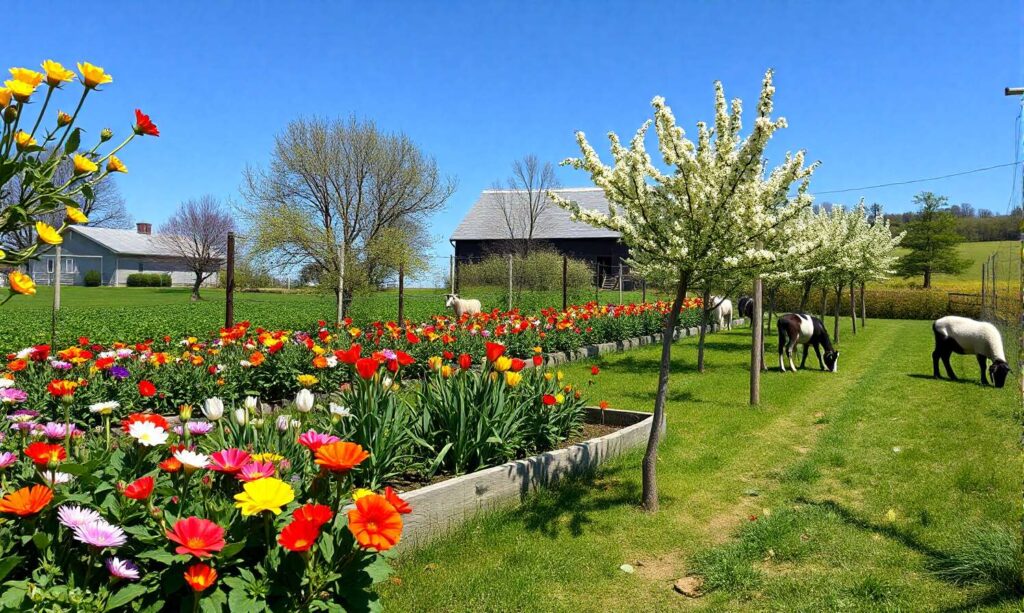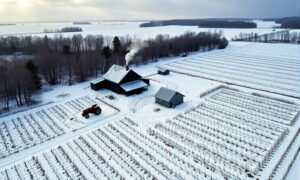
Spring is a time of renewal, and for those living on a homestead, it’s the season to rejuvenate the land and prepare for the busy months ahead. As the days grow longer and the ground begins to thaw, a flurry of activities awaits every homesteader. Whether you’re planting crops, tending to livestock, or simply maintaining your property, these spring activities will help you transform your 5-acre homestead into a productive oasis.
Preparing Your 5-Acre Homestead for Spring
Before diving into specific spring activities, it’s crucial to prepare your 5-acre homestead for the season. Proper preparation sets the stage for a successful and productive year, ensuring that your land, livestock, and equipment are all in optimal condition.
Inspecting and Cleaning Your Homestead After Winter
The first task on any homesteader’s spring to-do list should be inspecting and cleaning the property. After a long winter, it’s essential to check for any damage caused by snow, ice, or cold temperatures. Walk around your 5-acre homestead and look for any signs of wear and tear on buildings, fences, and equipment.
Checklist for Inspection:
- Check roofs for missing shingles or leaks.
- Inspect fences for sagging or broken sections.
- Examine equipment for rust or other damage.
- Look for signs of rodent infestations in sheds or barns.
Cleaning up the debris that has accumulated over the winter is also important. Fallen branches, dead leaves, and other organic material can clutter your land, potentially harboring pests and diseases. Clearing this debris not only improves the appearance of your homestead but also promotes healthier soil and plants. Think of it as spring cleaning, but with more mud and less Marie Kondo.
Servicing Equipment and Tools on Your Homestead for Spring
Living on a 5-acre homestead means relying heavily on tools and equipment to get the job done. Before spring activities kick into high gear, make sure all your machinery is in good working order. Start by servicing your lawnmowers, tractors, and other motorized equipment. Change the oil, check the filters, and sharpen the blades to ensure everything runs smoothly.
Tool Maintenance Tips:
- Sharpening Blades: A sharp blade on your mower or trimmer ensures a clean cut, which is healthier for your plants.
- Oil Changes: Regular oil changes extend the life of your equipment and keep it running efficiently.
- Storage Solutions: Properly storing tools after use, such as hanging them in a dry place, will prevent rust and prolong their usability.
Hand tools also need attention. Clean, sharpen, and repair any tools that have seen heavy use. Properly maintained tools not only last longer but also make your work easier and more efficient.
Spring Gardening on a 5-Acre Homestead
One of the most rewarding aspects of homesteading is gardening, and spring is the perfect time to start planting. With 5 acres at your disposal, the possibilities for gardening are nearly endless. From vegetable gardens to flower beds, spring gardening offers an opportunity to grow your own food and beautify your property.
Planning Your Spring Garden Layout
Before you begin planting, take some time to plan your garden layout. Consider the amount of sunlight each area of your 5-acre homestead receives throughout the day, as this will influence what you can plant and where. For example, sun-loving vegetables like tomatoes and peppers should be planted in areas that receive full sunlight, while shade-tolerant plants like lettuce and spinach can thrive in areas with less direct light.
Key Factors for Garden Layout:
- Sunlight Exposure: Ensure that sun-loving plants are placed in the most illuminated parts of your garden.
- Water Access: Position your garden beds near a water source to make irrigation easier.
- Wind Protection: Use natural barriers like shrubs or fences to protect delicate plants from strong winds.
When planning your garden, also think about crop rotation. Rotating crops each year helps prevent soil depletion and reduces the risk of pests and diseases. Designate different areas of your garden for different types of plants, and be sure to rotate them each season. Companion planting, such as pairing tomatoes with basil, can also deter pests and boost plant growth.
Preparing the Soil for Spring Planting
Soil preparation is a key spring activity on any 5-acre homestead. Healthy soil is the foundation of a successful garden, so it’s important to take the time to amend and condition it before planting.
Start by testing your soil’s pH and nutrient levels. Based on the results, you can add the necessary amendments, such as compost, lime, or fertilizer, to create the ideal growing conditions. Tilling the soil to a depth of at least 6-8 inches will help incorporate these amendments and aerate the soil, making it easier for roots to grow.
Soil Preparation Tips:
- Composting: Use organic compost to enrich your soil with nutrients and improve its texture.
- Mulching: Apply mulch to retain moisture, suppress weeds, and regulate soil temperature. Organic mulches, like straw or wood chips, break down over time, adding valuable nutrients to the soil.
Planting Spring Crops on Your 5-Acre Homestead
With the soil prepared and your garden layout planned, it’s time to start planting. Spring is an ideal time to plant a variety of crops, from vegetables and herbs to fruit trees and flowers.
Cool-Season Crops
Cool-season vegetables are a great choice for early spring planting. Crops like lettuce, peas, and carrots thrive in cooler temperatures and can be planted as soon as the ground is workable. These vegetables not only grow well in spring but also help you get an early start on your harvest season.
Examples of Cool-Season Crops:
- Lettuce: Quick-growing and versatile, perfect for salads.
- Peas: Great for vertical gardening and can be planted in early spring.
- Carrots: Grow well in loose, sandy soil; plant them as soon as the soil is thawed.
Warm-Season Crops
For warm-season vegetables like tomatoes, peppers, and cucumbers, it’s best to start them indoors and transplant them into the garden after the last frost. Starting seeds indoors gives you a head start on the growing season, ensuring a bountiful harvest by summer.
If you’re planting fruit trees or berry bushes, spring is the perfect time to get them in the ground. These perennials require a few years to mature, so planting them now ensures they’ll be productive in the future. Be sure to space them appropriately to allow for growth, and consider their sunlight and water needs when choosing a location.
Planting Tips for Warm-Season Crops:
- Transplanting: Harden off seedlings by gradually exposing them to outdoor conditions before planting.
- Spacing: Provide adequate space between plants to reduce competition for nutrients and water.
Flower Gardening
For those who enjoy flowers, spring is also the time to plant annuals and perennials. Not only do flowers add beauty to your homestead, but they also attract pollinators, which are essential for a healthy garden. Consider planting flowers like marigolds, zinnias, and sunflowers, which can also deter pests naturally.
Spring Livestock Management on a 5-Acre Homestead
Livestock care is a year-round responsibility, but spring brings its own set of challenges and opportunities. As the weather warms up, it’s important to focus on the health and well-being of your animals, ensuring they are ready for the productive months ahead.
Spring Health Checkups for Livestock
One of the most important spring activities for a 5-acre homestead is conducting health checkups on your livestock. After a long winter, your animals may need extra care and attention to ensure they’re in good health.
Start by scheduling a visit from your veterinarian for a thorough examination of all your animals. Vaccinations, deworming, and hoof trimming are all essential tasks that should be taken care of in the spring. In addition, check your livestock for any signs of illness or injury that may have gone unnoticed during the winter.
Spring Health Checkup Checklist:
- Vaccinations: Update all necessary vaccinations to prevent common diseases.
- Hoof Trimming: Regular hoof care prevents lameness and other foot problems.
- Deworming: Keep parasites under control by following a deworming schedule.
Providing a balanced diet is also crucial during the spring months. As pastures begin to green up, gradually transition your animals from winter feed to fresh grass. However, be cautious of overgrazing, as new spring grass can be rich in nutrients and may cause digestive issues if consumed too quickly.
Pasture Management for Spring Grazing
Pasture management is another critical aspect of spring livestock care. A well-managed pasture provides nutritious forage for your animals and helps maintain the health of your land.
Begin by assessing the condition of your pastures. Look for areas that may have been damaged over the winter and consider reseeding or fertilizing to encourage new growth. Rotational grazing is an effective strategy for maintaining pasture health. By moving your animals to different sections of the pasture throughout the spring, you can prevent overgrazing and allow the grass to recover between grazings.
Pasture Management Tips:
- Reseeding: Use a mix of grasses and legumes to promote diversity and soil health.
- Fencing: Ensure that fences are secure to manage grazing areas effectively.
- Water Systems: Check and repair water troughs or install new ones to ensure your livestock have a constant water supply.
Spring Maintenance Projects for Your 5-Acre Homestead
Beyond gardening and livestock care, spring is also the perfect time to tackle maintenance projects around your 5-acre homestead. These projects will help keep your property in top condition and prepare it for the busy summer months.
Repairing and Building Fences
Fences are a critical part of any homestead, and spring is the ideal time to repair or build them. Start by inspecting all the fences on your property, looking for any damage caused by winter weather. Repair or replace broken posts, wires, or boards to ensure your fences are secure.
If you’re planning to expand your livestock operations or garden areas, consider building new fences during the spring. Whether it’s constructing a new chicken run or creating a deer-proof garden fence, tackling these projects now will set you up for success later in the year.
Fence Building Tips:
- Material Selection: Choose durable materials like treated wood or metal to withstand the elements.
- Post Installation: Ensure posts are set deep enough to resist frost heave and animal pressure.
- Gate Placement: Plan gate locations for easy access to different sections of your homestead.
Building and Maintaining Raised Garden Beds
Raised garden beds are a popular choice for homesteaders, and spring is the perfect time to build or maintain them. Raised beds offer several advantages, including improved drainage, better soil control, and easier access for planting and harvesting.
If you’re building new raised beds, consider using rot-resistant wood, stone, or other durable materials. Fill the beds with a high-quality soil mix that’s rich in organic matter, and be sure to line the bottom with landscape fabric or hardware cloth to keep out pests.
For existing raised beds, spring maintenance includes adding fresh soil or compost, repairing any damaged sections, and ensuring the beds are level and well-drained.
Enhancing Wildlife Habitats on Your 5-Acre Homestead in Spring
One of the joys of living on a 5-acre homestead is the opportunity to create and enhance wildlife habitats. Spring is the perfect time to attract beneficial wildlife to your property, from pollinators to birds and small mammals.
Planting Native Species to Attract Wildlife
Native plants are the foundation of a healthy wildlife habitat. They provide food, shelter, and nesting sites for a variety of species, and they’re well-adapted to your local climate and soil conditions.
When selecting plants for your 5-acre homestead, choose a variety of native species that bloom at different times throughout the spring and summer. This ensures a continuous food source for pollinators like bees and butterflies. Additionally, consider planting shrubs and trees that produce berries or nuts to attract birds and other wildlife.
Wildlife Habitat Tips:
- Diversity: Create a mix of plants that provide year-round food sources.
- Water Features: Install a pond or birdbath to attract various species.
- Layered Planting: Use ground covers, shrubs, and trees to create multiple layers of habitat.
Creating Nesting Sites and Shelters for Wildlife
Providing nesting sites and shelters is another important spring activity for enhancing wildlife habitats on your 5-acre homestead. Birds, in particular, benefit from the addition of nesting boxes, which can be placed in trees or on fence posts around your property.
Small mammals, such as rabbits and squirrels, also need shelter. Creating brush piles, leaving hollow logs, or constructing small shelters can provide them with safe places to nest and hide from predators.
If you’re interested in attracting bats, which are excellent for natural pest control, consider installing bat houses in sunny, open areas of your homestead.
Conclusion
Spring is a season of growth and renewal, and for those living on a 5-acre homestead, it’s a time to prepare the land, care for livestock, and tackle important maintenance projects. By focusing on these spring activities, you’ll set the stage for a productive and enjoyable year ahead. Whether you’re planting your garden, managing your pastures, or enhancing wildlife habitats, each task brings you closer to achieving the full potential of your homestead.
Ready to make the most of your spring on a 5-acre homestead? Explore our other seasonal guides and tips for year-round homesteading success. Don’t forget to subscribe to our newsletter for regular updates and expert advice!
FAQs
- What are the first steps to take when preparing a 5-acre homestead for spring?
- Begin by inspecting your property for winter damage, cleaning up debris, and servicing your tools and equipment.
- Which crops should I plant in the spring on a 5-acre homestead?
- Cool-season vegetables like lettuce, peas, and carrots are ideal for early spring planting, while warm-season crops should be started indoors.
- How do I manage pastures for spring grazing?
- Implement rotational grazing and assess pasture conditions to ensure healthy growth and prevent overgrazing.
- What are the benefits of raised garden beds for spring planting?
- Raised beds improve drainage, soil control, and accessibility, making them perfect for spring gardening on a homestead.
- How can I attract wildlife to my 5-acre homestead in the spring?
- Plant native species, create water features, and provide nesting sites and shelters to attract a variety of wildlife.
- What maintenance projects should I prioritize in the spring?
- Focus on repairing fences, building new structures, and maintaining garden beds to prepare your homestead for the year ahead.
- Why is soil preparation important for spring planting?
- Proper soil preparation ensures that your plants have the nutrients and structure they need to thrive throughout the growing season.
- How can I enhance the health of my spring garden on a 5-acre homestead?
- Test your soil, add organic amendments, and practice crop rotation to maintain healthy soil and productive plants.
- What are the key considerations for spring livestock care?
- Conduct health checkups, manage pastures, and ensure a balanced diet to keep your animals healthy and productive.
- How do I create a wildlife-friendly landscape on my homestead?
- Plant a variety of native species, provide water sources, and create safe shelters to support a diverse range of wildlife.




